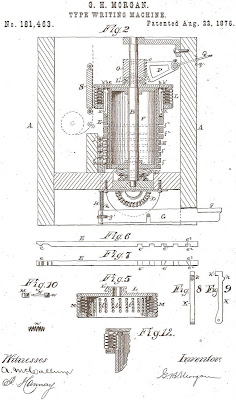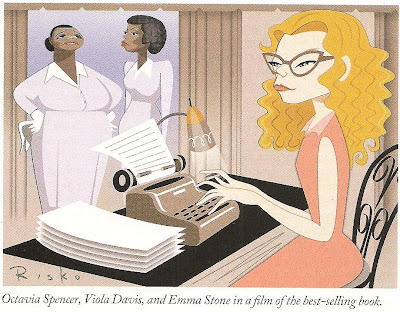AUGUST 22
Between 1875-1877, during the very earliest years of the Sholes and Glidden, George H. Morgan was one of those who, like James Bartlett Hammond and Lucien Stephen Crandall, wanted to change the typewriter into something entirely different.Morgan made three attempts to invent a typewriter which used a changeable typewheel and a hammer, both of which were to be employed on the later Hammond. Morgan’s typewriter would also type with variable spacing.
Michael Adler in Antique Typewriters (1997) refers to the Morgan designs thus: "Numerous patents were granted to George Morgan of Ohio from 1876 for machines using typewheels and hammers for printing in up to three colours using a roller for inking. The Typographical Machine Printing Company of Washington was to undertake production but the project did not materialise."
In fact, there were only three Morgan patents, and only the first of them was applied for while Morgan was living in Ohio.
Morgan was in Uhrichsville, Ohio, when, on November 13, 1875, he originally applied for a patent for his design. The patent was issued on February 15, 1876.
Morgan applied for further patents on February 5, 1876 (issued on this day in 1876) and March 14, 1876 (issued September 11, 1877). On each of these patents, Morgan is listed as living in Alexandria, Virginia. And both of these patents were assigned to the Typographical Machine Printing Company of the District of Columbia.
One has to wonder whether the hand of DC-based stenographer James Oglivie Clephane was in any of this. Clephane (above), who had assisted Christopher Latham Sholes and James Densmore in getting the Sholes and Glidden into production, was to form the National Typographic Company and be a major player in the development of the linotype machine.
For his first patent application, Morgan set out his objective as a machine on which “alphabetical characters are printed with due regard to their difference in size and the space which they occupy — that is, properly spaced, or with proper spaces between the letters, or each of them, and between each word, and with mechanism so arranged that the spaces between the letters may be increased or diminished, as occasion requires …”
Morgan also aimed at a means by which “different varieties of types, signs, numerals and other characters used in ordinary printing may be used without having to set up the type in fixed forms before printing therefrom, the machine printing the required letter or series of letters, or other sign, directly upon the paper from adjustable type carried on a wheel, the blow of the printing-hammer or platen and the movement or adjustment of the paper being effected by one and the same operation.”
For his second patent (below), Morgan referred back to the first by writing, “In another machine I accomplished this result by means of a revolving typewheel carrying a series of independent and adjustable type-carriers, each having a single letter in different styles of type, arranged so as to receive a back-and-forth movement at the will of the operator, so that the type required to be printed is presented to the action of a printing-hammer at the right moment.
“In this machine I accomplish the same result by means of a typewheel, also; but the types are not arranged upon independent and adjustable type-carriers, but are inserted radially in a revolving wheel, the letters of the different alphabets or styles being inserted in parallel circles, each style in its own circle - that is to say, all the capitals of the same style in one circle; all the common text-letters of the same style in another circle, italics in another, and so on, each different style or size of letter having a circle of its own, and so that each letter in its different styles shall run in a line parallel with the axis of the wheel.
"Said improved wheel is made adjustable, so as to bring the desired style of type opposite a fixed point where the required type is made, through suitable means, to receive an impulse or motion which brings it in contact with the paper to be printed.”
Morgan made further improvements for his third patent (above and below), relating to sliding cam-rods for the typewheel. “The mechanism I devised for operating the type of this wheel or cylinder consists of sliding cam-rods, which push out key-levers against the stems or heads of the stems of the type, a return movement, and a spring upon the stem of the type, withdrawing the type from a printing position.
“The improvements I now desire to secure by Letters Patent consist in the use of cam-rods which turn upon their axis without moving in a longitudinal or vertical direction, said turning cam-rods being journaled in a revolving cylinder, and operating so that, when turned on their axis, the cams will impart a reciprocating motion or motions to the type, whereby the type is first charged with the printing-ink, and then brought in contact with the paper to be printed, and then, if necessary, be brought into contact with a wiper, or device for cleaning the face of the type before again being charged with the printing-ink …
“The invention also consists in a new paper carrying device, which receives motion through suitable connecting mechanism from contact with cams on the turning rods, which also impart motion to the type. The paper-carrier remains stationary until the contact between its operating mechanism and the cam on the turning rod takes place, and then the motion continues so long as the type remains in contact with the paper, and a distance beyond sufficient to form the requisite space between the printed letter and the next letter to be printed; or the contact and consequent motion of the paper-carrier may begin before the type begins to print, and the necessary space between it and the last previous letter printed be thus obtained before the second letter is made to print.”
American poet, short story writer and satirist Dorothy Parker was born Dorothy Rothschild in Long Branch, New Jersey, on this day in 1893. She died in New York, aged 73, on June 7, 1967. Parker was best known for her wit, wisecracks and eye for 20th century urban foibles.
Parker often wrote for The New Yorker, and it was pleasing to see the typewriter return to the pages of The New Yorker for its August 15-22 issue of this year:
















No comments:
Post a Comment